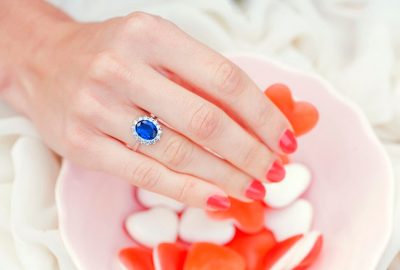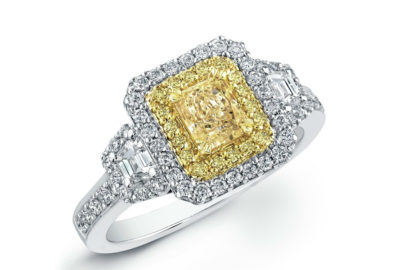Engagement Rings
Yellow sapphires are absolutely gorgeous and a perfect choice to bring a little light to your days! In all the excitement and anticipation, it’s easy to be fooled by fake stone. To help you avoid fraud, we’ve prepared a list of ways how to identify an original yellow sapphire!
Ask For a Certificate
Possibly the easiest way you can check the authenticity of a stone is to ask for a certificate. This way you are sure the stone was examined and approved by a trusted, official organization.
Certificates provided by some of the national gem societies (like the Gemological Institute of America or the American Gem Society) are good indicators that you have a pure sapphire on your hands.
Compare It With (Yellow) Glass
Many might claim that yellow glass and yellow sapphires are not so different. The truth is – of course, they are! One of the easiest ways to check if you’ve got a real gemstone is to compare it to a piece of yellow glass.
When placed next to each other, the difference between a real yellow sapphire and glass is drastic. The sapphire will be rich in shading and clearness, while the chunk of yellow glass will look pale in comparison.
Bubbles Or No Bubbles?
Any inclusion a yellow sapphire might posses shouldn’t be visible to the naked eye. So, if you notice tiny bubbles, or anything resembling liquid glass, inside your gemstone, it’s most likely fake.
Check for Scratches
Sapphires are unbending, hard stones that rank at 9.0 on the Mohs hardness scale. The only stone higher on the scale is a diamond, at 10.0! As a comparison, your fingernail ranks at 2.5.
Knowing this, it’s easy to check if your yellow sapphire is fake. If there are any scratches on your stone, it’s sadly not a real sapphire.
The X Sign
Carefully check the facets of your stone. An “X” cut, also known as scissors cut, is often present on fake (mostly synthetically manufactured) gemstones.
Is It Groovy?
If you’re in the possession of a 10x loupe, you can easily check for groves. A real yellow sapphire will be completely smooth, while a phony stone will have noticeable imperfections.
Under 10x magnification, you might notice grooves similar to that on a vinyl record. If that’s the case, the sapphire is synthetic.
Fillings
Negative space and inclusions can be found in any stone – of course, yellow sapphire is not exempt from them. When cutting gems, these imperfections can “rip” and cause a small hole to develop.

Trustworthy jewelers will keep the hole intact, perhaps as proof of the sapphire’s authenticity. Jewelers of a different kind might choose to fill this hole with paste or glass to make the stone look as though it’s of a higher quality than it actually is.
Shine a light on your stone and examine it – uneven patches can be a good indicator the stone has been filled. Fillings in your stone are something you want to avoid.
Hold It Close And Check For Warmth
If you’re dealing with a loose stone, you can simply hold the yellow sapphire in your hand to see if there’s a chance of it being fake.
A real, natural sapphire should feel warm in your palm. If, on the other hand, you don’t feel anything in particular, you should suspect that the stone you’re holding is synthetic.
Whether you’re choosing a perfect yellow sapphire for an engagement ring, a necklace, or a bracelet, you can make sure you have the real deal on your hands using these tips. Drop by one of our jewelry stores in Miami and make your pick today!
And if you want to match your sapphire jewelry with your clothing we got you covered in our another article.













































Leave a reply